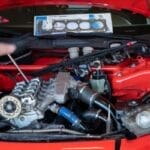Ensure your boat is ready for the water with this checklist
No matter how much experience you have on the water, prepping your boat – and your passengers – before leaving the dock can make for a more enjoyable experience.
To prepare for a safe and comfortable trip, review this pre-departure checklist to ensure your vessel is in good working order and well-stocked for the adventure:
- Documentation – Have all required documentation for planned activities, including boat registration, fishing permits and boater education cards readily accessible.
- Float Plan – File a float plan with a responsible party who will remain on land. Provide contact info, explain where you’re going, when you intend to return and what to do in case he or she doesn’t hear from you.
- Weather Forecast – Always check the forecast before you head out on the water. To regularly monitor any changes, keep a handheld radio onboard.
- Fuel – Before leaving, check that your fuel level is adequate for the trip and that other fluids, like oil and coolant, are at the proper levels.
- Batteries – Check to make sure the boat’s battery, as well as battery-operated items like flashlights and handheld radios, are fully charged and operational.
- Lights – Check to make sure you have properly functioning navigation and instrument lights and pack a flashlight, as well.
- Life Jackets – Ensure you have at least one U.S. Coast Guard-approved personal floatation device per passenger with a minimum of two onboard. If your boat is longer than 16 feet, you’ll also need a throwable device.
- Anchor – Keep at least one anchor, attached to an anchor line, and at least two fenders for docking onboard.
- Bilge – Before launching your boat, ensure the bilge is dry, clear of waste and has a properly functioning pump.
- Fire Extinguisher – Keep a U.S. Coast Guard-approved fire extinguisher securely mounted in an accessible place.
- Distress Signals – Store flares and day signals in a dry, accessible location and ensure all passengers onboard know how to use them. Also have a noise-making device, such as an air horn, bell or whistle, capable of producing a 4-second blast audible for at least 1/2 mile readily available.
- Tools – Keep a basic toolbox onboard with commonly used tools and spare parts like wrenches, screwdrivers, batteries, fuel filters, hull plugs and light bulbs.
- First-Aid Kit – Keep a well-stocked first-aid kit – and extra sunscreen – in an accessible location in case of accidents.
Find more tips for safely enjoying time on the water at eLivingtoday.com.
Photo courtesy of Getty Images
SOURCE:
eLivingtoday.com








































